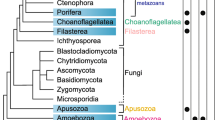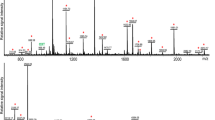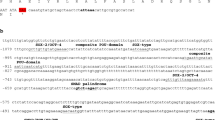Abstract
Ependymin (EPN) is a brain glycoprotein that functions as a neurotrophic factor in optic nerve regeneration and long-term memory consolidation in goldfish. To date, trueepn genes have been characterized in one order of teleost fish,Cypriniformes. In the study presented here, polymerase chain reactions were used to analyze the completeepn genes,gd (1480 bp), andsh (2071 bp), fromCypriniformes giant danio and shiner, respectively. Southern hybridizations demonstrated the existence of one copy of each gene per corresponding haploid, genome. Each gene was found to contain six exons and five introns. Genegd encodes a predicted 218-amino acid (aa) protein GD 93% conserved to goldfish EPN, whilesh encodes a predicted 214-aa protein SH 91% homologous to goldfish. Evidence is presented classifying proteins previously termed “EPNs” into two major categories: true EPNs and non-EPN cerebrospinal fluid glycoproteins. Proteins GD and SH contain all the hallmark features of true EPNs.
Similar content being viewed by others
References
Adams, D. S., and Shashoua, V. E. 1994. Cloning and sequencing the genes encoding goldfish and carp ependymin. Gene 141:237–241.
Anderson, M. J., Choy, C. Y. and Waxman, S. G. 1986. Selforganization of ependyma in regenerating teleost spinal cord: Evidence from serial section reconstructions. J. Embryol. Exp. Morph. 96:1–18.
Benowitz, L. I. and Shashoua, V. E. 1977. Localization of a brain protein metabolically linked with behavioral plasticity in the goldfish. Brain Res. 136:227–242.
Breathnach, R. and Chambon, P. 1981. Organization and expression of eukaryotic split genes coding for proteins. Ann. Rev. Biochem. 50:349–383.
Chernoff, E. A. G. 1994. Cutting the cord: Ependymal cells in spinal cord regeneration. Am. Zoologist 34(5):8aa.
Chernoff, E. A. G., and Stocum, D. L. 1995. Developmental aspacts of spinal cord and limb regeneration. Dev. Growth Diff. 37: 133–147.
Doherty, P., Williams, E., and Walsh, F. S. 1995. A soluble chimeric form of the L1 glycoprotein stimulates neurite outgrowth. Neuron 14:57–66.
Egar, M., Simpson, S. B., and Singer, M. 1970. The growth and differentiation of the regenerating spinal cord of the lizard,Anolis carolinensis. J. Morphol. 131:131–152.
Egar, M., and Singer, M. 1972. The role of ependyma in spinal cord regeneration in the urodele,Triturus. Exp. Neurol. 37:422–430.
Ganss, B. and Hoffmann, W. 1993. Calcium binding to sialic acids and its effect of the conformation of ependymins. Eur. J. Biochem. 217:275–280.
Königstorfer, A., Sterrer, S., Eckerskorn, C., Lottspeich, F., Schmidt, R., and Hoffmann, W. 1989a. Molecular characterization of an ependymin precursor from goldfish brain. J. Neurochem. 52: 310–312.
Königstorfer, A., Sterrer, S. and Hoffmann, W. 1989b. Biosynthesis of ependymins from goldfish brain. J. Biol. Chem. 264: 13689–13692.
Kruse, J., Mailhammer, R., Wernecke, H., Faissner, A., Sommer, I., Goridis, C., and Schachner, M. 1984. Neural cell adhesion molecules and myelin-associated glycoprotein share a common carbohydrate moiety recognized by monoclonal antibodies L2 and HNK-1. Nature 311:153–155.
Kyte, J. and Doolittle, R.F. 1982. A simple method for displaying the hydropathic character of a protein. J. Mol. Biol. 157:105–132.
Marshall, R. D. 1974. The nature and metabolism of the carbohydrate-peptide linkages of glycoproteins. Biochem. Soc. Symp. 40:17–26.
Müller-Schmid, A., Rinder, H., Lottspeich, F., Gertzen, E. M. and Hoffmann, W. 1992. Ependymins from the cerebrospinal fluid of salmonid fish: gene structure and molecular characterization. Gene 118:189–196.
Müller-Schmid, A., Ganss, B., Gorr, T., and Hoffmann, W. 1993. Molecular analysis of ependymins from the cerebrospinal fluid of the orders Clupeiformes and Salmoniformes: No indication for the existence of an Euteleost infradivision. J. Mol. Evol. 36:578–585.
O'Hara, C. M., Egar, M. W., and Chernoff, E. A. G. 1992. Reorganization of the ependyma during axolotl spinal cord regeneration: Changes in intermediate filament and fibronectin expression. Dev. Dynamics 193:103–115.
Proudfoot, N. J. 1989. How RNA polymerase II terminates transcription in higher eukaryotes. Trends Biochem. Sci. 14:105–110.
Rinder, H., Bayer, T. A., Gertzen, E. M., and Hoffmann, W. 1992. Molecular analysis of the ependymin gene and functional test of its promoter region by transient expression inBrachydanio rerio. DNA and Cell Biol. 11:425–432.
Sanger, F., Nicklen, S. and Coulson, A. R. 1977. DNA sequencing with chain terminating inhibitors. Proc. Natl. Acad. Sci. USA 71: 5463–5467.
Schmidt, R. 1986. Biochemical participation of glycoproteins in memory consolidation after two different training paradigms in goldfish. Adv. Biosci. 59:213–222.
Schmidt, J. T. and Shashoua, V. E. 1988. Antibodies to ependymin block the sharpening of the regenerating retinotectal projection in goldfish. Brain Res. 446:269–284.
Schmidt, R., Rother, S., Schlingensiepen, K., and Brysch, W. 1992. Neuronal plasticity depending on a glycoprotein synthesized in goldfish leptomeninx. Prog. Brain Res. 91:7–12.
Seidah, N. G., Day, R., Marcinkiewicz, M., Benjannet, S., and Chretien, M. 1991. Mammalian neural and endocrine pro-protein and pro-hormone convertases belonging to the sutilisin family of serine proteinases. Enzyme 45:271–284.
Shashoua, V. E. 1976. Brain metabolism and the acquisition of new behaviors, I. Evidence for specific changes in the pattern of protein synthesis. Brain Res. 111:347–364.
Shashoua, V. E. 1981. Extracellular fluid proteins of goldfish brain: studies on concentration and labeling patterns. Neurochem. Res. 6:1129–1147.
Shashoua, V. E. 1985. The role of brain extracellular proteins in neuroplasticity and learning. Cell. Molec. Neurobiol. 5:183–207.
Shashoua, V. E. 1986. The role of neurosecretory cells in learning and memory. Adv. Biosci. 61:245–254.
Shashoua, V. E. 1988. Monomeric and polymeric forms of ependymin: A brain extracellular glycoprotein implicated in memory consolidation processes. Neurochem. Res. 13:649–655.
Shashoua, V. E. 1991. Ependymin, a brain extracellular glycoprotein, and CNS plasticity. Annals NY Acad. Sci. 627:94–114.
Shashoua, V. E., and Moore, M. E. 1978. Effect of antisera to β and goldfish brain proteins on the retention of newly acquired behavior. Brain Res. 148:441–449.
Shashoua, V. E., Daniel, P. F., Moore, M. E., and Jungalwala, F. B. 1986. Demonstration of glucuronic acid on brain glycoproteins which react with HNK-1 antibody. Biochem. Biophys. Res. Commun. 138:902–909.
Shashoua, V. E., and Hesse, G. W. 1989. Classical conditioning leads to changes in extracellular concentrations of ependymin in goldfish brain. Brain Res. 484:333–339.
Shashoua, V. E., Nolan, P. M., and Milinazzo, B. 1991. Ependymin promotes neurite growth in neuroblastoma cell cultures. Soc. Neurosci. Abst. 17:95, 12.
Simpson, S. B. Jr. 1968. Morphology of the regenerated spinal cord in the lizard,Anolis carolinensis. J. Comp. Neurol. 134:193–210.
Singer, M., Nordlander, R. H., and Egar, M. 1979. Axonal guidance during embryogenesis and regeneration in the spinal cord of newt: The blueprint hypothesis of neuronal pathway patterning. J. Comp. Neurol. 185:1–22.
Sterrer, S., Königstorfer, A., and Hoffmann, W. 1990. Biosynthesis and expression of ependymin homologous sequences in zebrafish brain. Neuroscience 37:277–284.
Author information
Authors and Affiliations
Corresponding author
Rights and permissions
About this article
Cite this article
Adams, D.S., Kiyokawa, M., Getman, M.E. et al. Genes encoding giant danio and golden shiner ependymin. Neurochem Res 21, 377–384 (1996). https://doi.org/10.1007/BF02531655
Accepted:
Issue Date:
DOI: https://doi.org/10.1007/BF02531655




